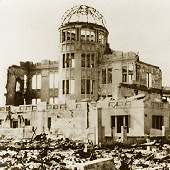|
|
|
 |
|
|
|
|
 |
For the Future: A Gift of Love from Dr. Junod
In 1943, Dr. Junod returned to Geneva, and the following June he married Eug nie Perret. They had not been married long before Dr. Junod was asked by the ICRC in 1945 to go to Japan as head of its delegation. He left Eug nie Perret. They had not been married long before Dr. Junod was asked by the ICRC in 1945 to go to Japan as head of its delegation. He left Eug nie, who was pregnant with their first child, behind in Geneva and headed for Japan. nie, who was pregnant with their first child, behind in Geneva and headed for Japan.
|
Dr. Junod traveled to Tokyo via Cairo through Siberia and Manchuria, the roundabout route approved by the Japanese Imperial Army. Along the way he stopped at a prison camp in Mukden (Shenyang) where, after repeated refusals by the Japanese Army, he succeeded in meeting briefly with Lt. Gen. Arthur Percival of the British Army, U.S. Army Gen. Jonathan Wainwright and A.W.L. Tjarda van Starkenborgh Stachouwer, Governor-General of the Dutch East Indies. This act reflected the Red Cross spirit of love for others and respect for human life without regard for one's own safety. Dr. Junod later had the opportunity to meet Lt. Gen. Percival and Gen. Wainwright again in Yokohama.
After a journey of about two months, Dr. Junod finally arrived in Tokyo on August 9, three days after the dropping of the atomic bomb on Hiroshima. While continuing to work for the release of Allied prisoners in the Omori Prison Camp in Tokyo Bay, he tried to gather information on the situation in Hiroshima. Just after the bombing, American radio and newspaper reports heralded the extraordinary power of the bomb. The Japanese press also reported on the destruction, which was almost beyond description, but a few days later all reporting was prohibited.
Dr. Junod heard many secondhand reports on the bombing, but the stories were so horrible that they were painful to listen to and he could not believe they were true: a blinding light suddenly flashing out of a peaceful sky, a typhoon of glare, heat and wind that swept suddenly over the earth and left a sea of fire behind it. People who had been there moments before were reduced to lumps of charcoal. People's skin melted and their clothing stuck to their bodies. Crying for water, they dove into rivers. The number of dead was unknown, but it was a catastrophe, and more than 200,000 were believed to be dead or injured. Thousands of those whose lives had been spared were dying every day with strange, new and inexplicable symptoms.
On September 1, the Japanese Foreign Ministry first showed Dr. Junod photographs of Hiroshima depicting the hell on earth that had been created when the city was consumed by a hot wind of 6,000 degrees. The next day a telegram arrived from an investigator who had been sent to Hiroshima. "Situation horrifying... Ninety percent of town razed... All hospitals destroyed or severely damaged... Have visited two provisional hospitals: conditions indescribable... Grave shortage of material, bandages, medicaments... Appeal allied high command asking supplies be parachuted immediately into center of town...Immediate action necessary..." More than 100,000 people had vanished in an instant, and another 100,000 were suffering and could not get proper treatment.
Dr. Junod raced to GHQ with the photographs and the telegram and negotiated a relief effort. The negotiations were difficult, but five days later he received a reply from Gen. Douglas MacArthur stating that the U.S. Army would not provide aid directly but that 15 tons of medicine and other medical supplies would be provided. There is no doubt that MacArthur's gratitude to Dr. Junod as benefactor of the Allied Forces in China lay behind his decision. On the morning of September 8, six U.S. Army planes took off from Atsugi Air Field carrying 15 tons of medical supplies. As they entered the skies over the city, Dr. Junod saw below him "the chalky desert looking almost like ivory in the sun."
While looking into the extent of the destruction, Dr. Junod also treated victims. Among the 15 tons of medical supplies that he had succeeded in getting to Hiroshima was penicillin, which had not yet been introduced to Japan. The Japanese doctors were astonished by its effectiveness. Many more victims would have died had Dr. Junod not provided medical supplies. He was without a doubt the right man to serve as Hiroshima's benefactor. Dr. Junod was unable to go to Nagasaki, but he spearheaded the effort to get medicine and other relief supplies to the city, and records show that the lives of many people were saved as a result.
|
|
|
|
|